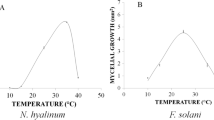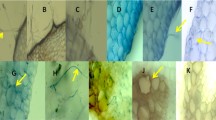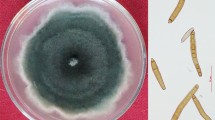Abstract
Rice cultivars showed differential reaction to various isolates of Helminthosporium oryzae, the brown spot pathogen. The calluses obtained from those cultivars behaved in a similar manner to the mycelial growth of pathogenic isolates on them. However, amount of inoculum, size of the callus and period of incubation influenced the reaction of the callus to the fungal isolates.
Similar content being viewed by others
References
Anonymous (1980) Standard Evaluation System for Rice. International Rice Testing Program. The International Rice Research Institute, Los Banos, Philippines. 44 p
Behnke, M (1979) Selection of potato callus for resistance to culture filtrates of Phytophthora infestans and regeneration of resistant plants. Theor. Appl. Genet. 55: 69–71
Behnke, M (1980a) Selection of dihaploid potato callus for resistance to the culture filtrate of Fusarium oxysporum. Z. Pflanzenzucht. 85: 254–258
Behnke, M (1980b) General resistance to late blight of Solanum tuberosum plants regenerated from callus resistant to culture filtrates of Phytophthora infestans. Theor. Appl. Genet. 56: 151–152
Gengenbach, BG & Green, CE (1975) Selection of T-cytoplasm maize callus cultures resistant to Helminthosporium maydis race T pathotoxin. Crop Sci. 15: 645–649
Gengenbach, BG, Green, CE & Donovan, CM (1977) Inheritance of selected pathotoxin resistance in maize plants regenerated from cell cultures. Proc. Nat. Acad. Sci. USA 74: 5113–5117
Haberlach, GT, Budde, AD, Sequeira, L & Helgeson, JP (1978) Modification of disease resistance of tobacco callus tissues by cytokinins. Plant Physiol. 62: 522–525
Helgeson, JP, Haberlach, GT & Upper, CD (1976) A dominant gene conferring disease resistance to tobacco plants is expressed in tissue cultures. Phytopathology 66: 91–96
Helgeson, JP, Kemp, JD, Haberlach, GT & Maxwell, DP (1972) A tissue culture system for studying disease resistance: the black shank disease in tobacco callus cultures. Phytopathology 62: 1439–1443
Holliday, MJ & Klarman, WL (1979) Expression of disease reaction types in soybean callus from resistant and susceptible plants. Phytopathology 69: 576–578
Ingram, DS (1967) The expression of R-gene resistance to Phytophthora infestans in tissue cultures of Solanum tuberosum. J. Gen. Microbiol. 49: 99–108
Ingram, DS & Robertson, NF (1965) Interaction between Phytophthora infestans and tissue cultures of Solanum tuberosum. J. Gen. Microbiol. 40: 431–437
Larkin, PJ & Scowcroft, WR (1983) Somaclonal variation and eyespot toxin tolerance in sugarcane. Plant Cell Tiss. Org. Cult. 2: 111–121
Maronek, DM & Hendrix, JW (1978) Resistance to race O of Phytophthora parasitica var. nicotianae in tissue cultures of a tobacco breeding line with black shank resistance derived from Nicotiana longiflora. Phytopathology 68: 233–234
Miller, SA, Davidse, LC & Maxwell, DP (1984) Expression of genetic susceptibility, host resistance and non-host resistance in alfalfa callus tissue inoculated with Phytophthora megasperma. Phytopatholgoy 74: 345–348
Murashige, T & Skoog, F (1962) A revised medium for rapid growth and bioassays with tobacco tissue cultures. Physiol. Plant. 15: 473–497
Ogasawara, N, Uchiyama, T, Oohashi, T & Tanaka, H (1977) Responses of callus tissues of rice, to inoculation of conidia of Pyricularia oryzae Cavara and other fungi. Ann. Phytopathol. Soc. Japan 43: 246–254
Sacristan, MD (1982) Resistance responses to Phoma lingam to plants regenerated from selected cell and embryogenic cultures of haploid Brassica napus. Theor. Appl. Genet. 61: 193–200
Thanutong, P, Furusawa, I & Yamamoto, Y (1983) Resistant tobacco plants from protoplast derived calluses for their resistance to Pseudomonas and Alternaria toxins. Theor. Appl. Genet. 66: 209–215
Trigiano, RN, VanDyke, CG, Spurr, HWJr & Gray, DJ (1984) Infection and colonization of tobacco callus by Peronospora tabacina. Phytopathology 74: 280–285
Uchiyama, T, Kato, H, Ito, M, Ogasawara, N (1984) Changes in responses to the inoculation of fungi by varying the number of subcultures of rice callus culture. Ann. Phytopathol. Soc Japan 50: 176–188
Vidhyasekaran, P, Borromeo, ES, Ling, DH & Mew, TW (1988) Use of phytotoxin and tissue culture in evolving disease resistant rice germplasm. In: Genetic Manipulation in Crops. (pp 102–104) Cassell Publishers, London
Vidhyasekaran P, Ling DH, Borromeo ES, Zapata FJ & Mew TW (1991) Selection of brown spot-resistant rice plants from Helminthosporium oryzae toxin-resistant calluses. Ann. Appl. Biol. (in press)
Author information
Authors and Affiliations
Rights and permissions
About this article
Cite this article
Vidhyasekaran, P., Borromeo, E.S., Ling, D.H. et al. Relationship between growth rate of Helminthosporium oryzae isolates on calluses of rice cultivars and their disease reaction on rice plants. Plant Cell Tiss Organ Cult 24, 237–241 (1991). https://doi.org/10.1007/BF00033483
Received:
Accepted:
Issue Date:
DOI: https://doi.org/10.1007/BF00033483




